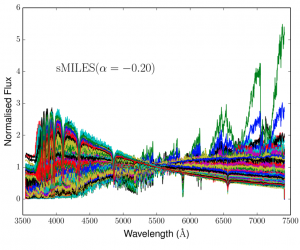Supervisor: Dr Anne Sansom (Reader in Astrophysics)
To understand galaxies we need to understand the spectra of their stars. We have built a new library of theoretical spectra from which to make composite spectra for galaxies. By fitting these to data for real galaxies we can extract information about when and how their stars were made. This project will extend our theoretical and observational work on individual star spectra to build new model populations of stars, making use of the latest stellar isochrones. An important component of these new models is their ability to measure the amounts of chemical elements formed through capture of alpha particles, called alpha elements and of carbon. These elements form major sources of opacity in the atmospheres of stars. The aim is to probe the chemical evolution patterns and ages in ellipticals, lenticulars and spiral bulges in the local Universe.
Large scale stellar and galaxy surveys are available to aid this PhD project, including multi-waveband galaxy data from the Galaxy and Mass Assembly (GAMA) project, of which Sansom is a consortium member, and the Sloan Digital Sky Survey (SDSS). Stellar spectra from the MILES library and our new theoretical model spectra of stars will be used to investigate different parts of UV/optical/IR wavebands for extracting information on ages and chemical abundance patterns in the stars and galaxies. We will build on techniques being developed and applied in a variety of ways, by Sansom and collaborators. Spectroscopic data from large optical telescopes (including SALT) are available and there will be opportunities to obtain more observations and gain observing experience and experience in stellar population analysis techniques during the PhD.
Examples of key questions to be addressed are:
*How accurately can we model the UV and IR spectra of stars and what useful element sigutures are there in these spectral regions? What is missing from the latest models?
*How do the abundances of elements vary in different types of galaxies? How do they vary with galaxy mass for a given type of galaxy? What does this tell us about their relative star formation histories and stellar initial mass functions?
*Does conformity of evolution in close pairs of galaxies affect abundance patterns and stellar population ages? More generally, what are the environmental influences on stellar populations in galaxies?
*What are the main mechanisms for quenching star formation in galaxies as they evolve? How long does this quenching take in different types of galaxies?
Masters by Research projects are also available.
For more background information and past projects see this description and for more details see my web pages or email me at AESansom@uclan.ac.uk .

